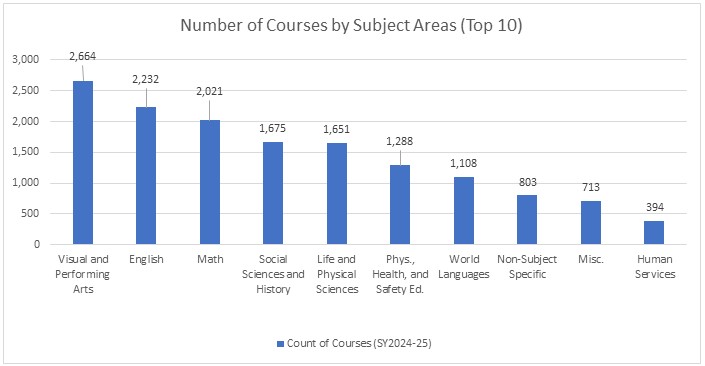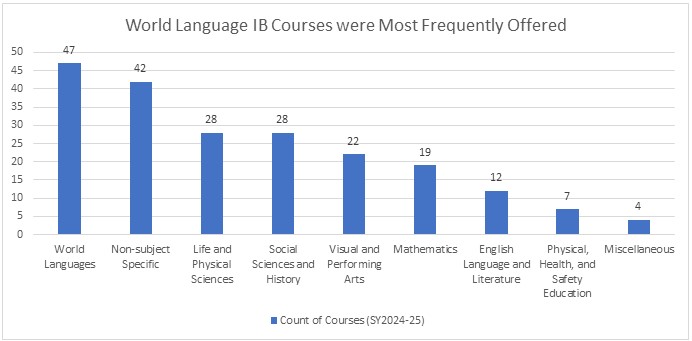OSSE collects new data to broaden our understanding of the student experience. Collecting course data for the first time is telling us the courses that schools are offering as well as who is teaching and who is enrolled. We has expanded the second year of our statewide course data collection, with continued commitment and collaboration from the local education agencies (LEAs) and state public agencies (SPAs, which are part of the Department of Youth Rehabilitation Services [DYRS] and Department of Corrections [DOC] Jail Education Program). As discussed in previous data blogs on statewide course data, the primary goals of this data collection process include but are not limited to:
- Collect and share actionable course data that will strengthen the ESSA State Plan Accountability System;
- Improve OSSE’s ability to better perform its core compliance and monitoring functions;
- Streamline the data collection process and lessen course burdens on LEAs and SPAs in the long term; and
- Provide professional support to LEAs and SPAs and their staff based on course offerings
This blog introduces course data that OSSE began collecting last school year and intends to provide an overview of different types of courses in the 2024-25 School Year OSSE State Course Data. This year’s catalog data will be linked with teacher/section- and student-level course data OSSE is collecting from LEAs and SPAs via Automated Data Transfer (ADT) 2.0.
Subject Areas
Figure 1

*Miscellaneous (Misc.) Course Subject Area — SCED Framework/Classification System categorizes any courses that cannot be assigned to any of the other Course Subject Areas as courses with a miscellaneous Course Subject Area. Miscellaneous courses often include activities or skills that are applicable to a range of topics, such as Standardized Test Preparation (22001), Career Exploration (22151), or Employability Skills (22152).
**Non-Subject-Specific is used only at the prior-to-secondary level. The Non-Subject-Specific Subject Area was designed specifically for courses conveying prior-to-secondary-level content.
Figure 1 above shows the number of courses LEAs and SPAs submitted for top 10 subject areas. The change in total number of courses is a result of one less LEA in the District as well as better data quality this year, given some LEAs have consolidated some courses and removed duplicates in the submission this year. The course subject rankings remain consistent year-over-year for the top 10 but varied slightly for subjects that ranked below 10 and do not appear on Figure 1. For example, more communications and audio/visual technology and health care sciences courses were reported for the 2024-25 school year, and fewer hospitality and tourism courses were reported this year.
Data from the 2023-24 school year told OSSE that there were the greatest number of Arts, English Language Arts (ELA), and Math courses among DC schools, and this year’s data, along with Student and Section Course Data OSSE is collecting for the first time, will help OSSE paint a more detailed picture on actual enrollment trends.
Course Level
Table 1 below lists different types of course levels and the number of course submissions for each Course Level. While more than 90 percent of all submitted courses (n=14,004) were categorized as General courses, DC LEAs and SPAs reported 441 Enriched or Advanced courses, 408 Honors courses, and 160 College-Level courses. DC LEAs also reported 420 Basic or Remedial courses to meet the needs of diverse learners. LEAs and SPAs submitted the least number of College Level (C) courses, as these are designed to be credit bearing at a postsecondary institution, including Dual Enrollment courses. Table 1 provides the definitions of each course level, and Table 2 lists the number of LEAs and SPAs that submitted each of these six course levels.
Table 1
Table 2
World Languages
In DC, 43 LEAs and SPAs submitted at least one World Language course. There are 84 unique World Languages courses, and 1,102 total courses were submitted in the following languages (Table 2). “Spanish for Young Learners (prior-to-secondary),” particularly, was submitted 329 times, by 18 LEAs, which accounts for 30 percent of the total World Language courses.
Table 3
*Four general course offerings reported in the 2024-25 school year are introduction to world languages and cultures course.
Although not all of these World Languages course were Dual Language or Language Immersion courses, the course offerings listed in Table 2 above do not exactly reflect all of the translation languages required by DC Language Access Act (Amharic, Chinese, French, Korean, Spanish, Vietnamese) or the most common languages (Spanish, American Sign Language, Amharic, French, Arabic, and Mandarin) DC residents utilize. For example, even though DC is known to traditionally have a large Ethiopian immigrant population, Amharic is not largely taught in DC schools.
Advanced Placement (AP) / International Baccalaureate (IB) Courses
AP Courses
Thirty-five schools of 17 LEAs offer 403 AP courses across DC, an increase from 373 in the 2023-24 school year (Table 4). Of 35 schools that offer AP courses, 27 schools offer five or more AP courses, and 8 schools offer fewer than five AP courses. Overall, there has been a slight increase in the number of schools reporting that they offer AP courses.
Table 4
IB Courses
Five LEAs offer 209 International Baccalaureate (IB) courses across nine subject areas shown below (Figure 2). The steep change of nine to 42 for Non-subject Specific IB courses was due to the way IB Primary Years Program courses were reported from an LEA this year and is not considered a data error. Table 4 ranks the number of course offerings. DC LEAs offer 38 unique IB courses across DC. Among 38 unique IB courses, eight IB courses accounted for half of all IB course offerings. Four LEAs offered IB Primary Years program, and nearly two thirds of the IB course offerings were for high school students.
Figure 2

Table 5
*Table 5 only lists 11 courses with more than five course offerings using the specific OSSE Course Code. It omits IB courses with fewer than five course offerings.
Future blog posts will discuss dual enrollment, Montessori, career and technical education (CTE), and other special courses related to our course characteristics on the Course Catalog Collection template located on the Course Data Collection website.
OSSE will also explore with community and LEA stakeholders, the best way for OSSE to share these data in a meaningful and actionable way. In addition to the Course Catalog data collection, OSSE will soon have a more accurate understanding of course offerings and course taking patterns once Student and Section Course Data Collection comes to fruition. These data will empower OSSE to support all learners in DC, especially those furthest from opportunity, by ensuring that they have equal access to appropriate and high-quality coursework and learning environments.
Learn More
For more information about the 2024-25 school year course data collection, please see OSSE’s Course Data Collection website, where there is a copy of the 2024-25 School Year LEA Course Data Collection Policy Guide and the OSSE State Course Catalog V3.


